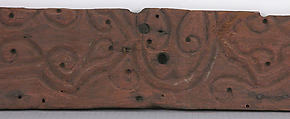Panel
Not on view
This carved wooden panel came to the museum through an unusual source, the British art and antiquity dealer Sydney Burney (1878–1951), known mostly for his trade in African and modern art and for having served as the President of the British Antique Dealers’ Association. His only ventures into the market for Islamic art are limited to an assemblage of carved wood which he sold to the Met, the British Museum, and the Louvre. It is yet unknown how the London-based dealer obtained these artifacts, of which the large part are said to have been found in Tikrit in Iraq.
The style of the carving, with its beveled surfaces, absence of negative space, and symmetrical patterns of stylized vegetal forms, is similar to artistic traditions known from the ninth century in Iraq, and elsewhere in the Islamic world. In Cairo, a carved tie-beam in the Mosque of al-Hakim (dated between 990 and 1013), is highly comparable to this piece.
Due to rights restrictions, this image cannot be enlarged, viewed at full screen, or downloaded.
This artwork is meant to be viewed from right to left. Scroll left to view more.




